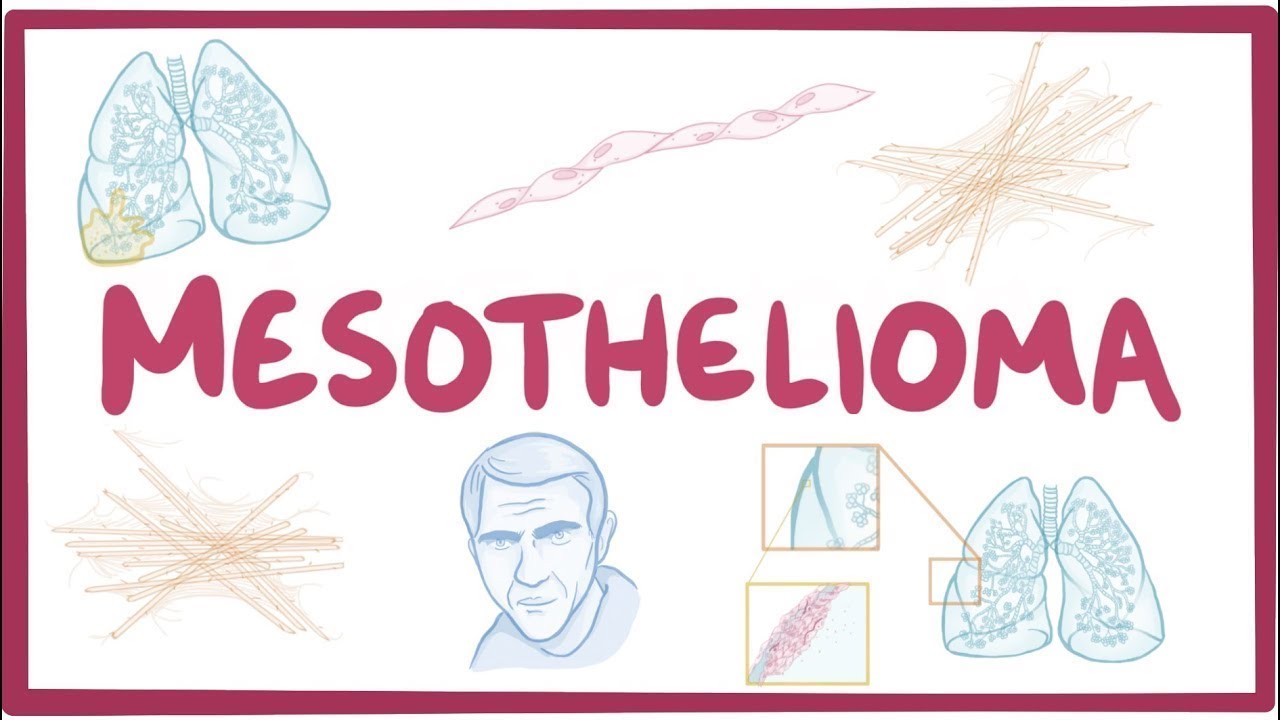Mesothelioma Causes, Symptoms And Treatments
In this article, you will learn what mesothelioma treatment, mesothelioma causes, mesothelioma symptoms, mesothelioma diagnosis, what are the first signs of mesothelioma?, mesothelioma radiology, mesothelioma prognosis are all about

What Is Mesothelioma?
Mesothelioma is cancer of the mesothelium, a membrane that lines the inside of the body’s cavities, such as the abdomen or chest. Three out of every four cases of mesothelioma disease begin in the chest cavity. Mesothelioma can also begin in the abdominal cavity and around the heart.
Regardless of where they originate, malignant cells from the mesothelium can invade and damage nearby tissues. Cancer cells can also metastasize, or spread, to other parts of the body.
Often by the time mesothelioma is diagnosed, the disease is advanced. The 5-year survival rate is around 5% to 10%. Most patients with mesothelioma of the lung die as a result of respiratory failure or pneumonia. Some patients get a small-bowel obstruction when the tumor extends through the diaphragm, a muscle that separates the chest and abdominal cavity. A smaller number people die of complications of the heart when the tumor invades the pericardium — a thin sac that surrounds the heart — and the heart itself.
Is mesothelioma treatable?
Although there is no cure for mesothelioma, there are treatment options available, including surgery, chemotherapy and radiation therapy.
See Also: Live A Healthy Lifestyle: Top 10 Practical Health Tips You Should Know
Causes of Mesothelioma
What is the main cause of mesothelioma?
The only known cause of malignant mesothelioma is exposure to asbestos.
The main risk factor for mesothelioma is working with asbestos. Asbestos is a group of minerals with thin microscopic fibers. Because these fibers are resistant to heat, fire, and chemicals and do not conduct electricity, asbestos has been mined and used widely in the construction, automotive, and other industries.
If tiny asbestos fibers are released into the air, as they are in the manufacturing process, they can be inhaled or swallowed, leading to serious health problems. As many as 75% of mesothelioma cases can be linked to exposure to asbestos at work. There is also some evidence that family members and others living with asbestos workers have an increased risk of developing mesothelioma, and possibly other asbestos-related diseases. This risk may be the result of exposure to asbestos dust brought home on the clothing and hair of asbestos workers. Cases of mesothelioma have also been seen in people living close to asbestos mines.
However, mesothelioma has been reported in some individuals without any known exposure to asbestos. Other, uncommon, but possible causes include:
Zeolites. These minerals are chemically related to asbestos. One of these related minerals, erionite, is common in the soil in some areas of Turkey, according to the American Cancer Society. Exposure to erionite is believed to be responsible for high rates of mesothelioma rates in those areas.
Genetics. Some experts believe certain people may be genetically predisposed to mesothelioma. Rates of the disease vary among populations.
See Also: How To Get Rid Of Acne, Spots, Stretch Marks, Blemishes, Wrinkles Within Two Weeks
Symptoms of Mesothelioma
Mesothelioma symptoms commonly do not appear until 20 to 50 years after initial asbestos exposure.
The main symptoms of mesothelioma of the lungs are shortness of breath and chest pain. Accumulation of fluid in the pleura caused by the mesothelioma, if sufficiently large, may also contribute to the shortness of breath.
What are the most common symptoms of mesothelioma?
Mesothelioma symptoms vary based on type, but commonly include coughing, shortness of breath, chest pain or abdominal pain and buildup of fluid.
Symptoms of peritoneal (abdominal) mesothelioma can include:
- Weight loss
- Swelling and pain in the abdomen
- Blood clotting abnormalities
- Bowel obstruction
- Anemia
- Fever
If cancer has spread to other parts of the body, symptoms may include pain, swallowing difficulties, or swelling of the neck or face.
Because many conditions share these symptoms, having these symptoms doesn’t necessarily mean you have mesothelioma. It’s important to see your doctor to determine what is causing them.
Medical History and Physical Exam
Because mesothelioma is uncommon, it is often misdiagnosed at first. If you have symptoms that suggest you might have mesothelioma, your doctor will likely take a complete medical history to check for symptoms and possible things that raise your risk of having the disease, especially asbestos exposure. Exposure to asbestos is the No. 1 thing that makes mesothelioma more likely.
Your doctor will also ask about your general health and do an exam to check for possible signs of mesothelioma. These may include fluid in the chest cavity, abdomen, or pericardium (the thin membrane around the heart).
Depending on the findings of the exam, your doctor may refer you for mesothelioma testing.
Tests for Mesothelioma
There are several different types of mesothelioma tests. These include:
Blood tests. Blood levels of 3 substances — fibulin-3, osteopontin, and soluble mesothelin-related peptides (SMRPs) — are often higher in people with mesothelioma. Although these blood tests cannot confirm a diagnosis of mesothelioma — more study is needed before they can be of reliable use in a clinical setting — high levels of these substances make the disease more likely.
Fluid and tissue sample tests. If you have a buildup of fluid in the body that may be related to mesothelioma, your doctor can remove a sample of the fluid by putting a needle through the skin into the area of fluid buildup. The fluid can then be examined under a microscope for cancer cells. If cancer cells are found, further tests can tell if the cancer is mesothelioma.
This test goes by different names, depending on where the fluid is:
- Thoracentesis — chest cavity
- Paracentesis — abdomen
- Pericardiocentesis — membrane around the heart
Even if your doctor does not find mesothelioma cells in fluid, that doesn’t necessarily mean you don’t have mesothelioma. Sometimes samples of actual tissue (biopsies) are needed to diagnose mesothelioma.
Biopsies. There are ways to remove tissue to be examined for mesothelioma. They include:
- Needle biopsy. This involves inserting a long, hollow needle through the skin to remove a tiny piece of a tumor. Your doctor may use imaging tests to guide the needle into the tumor. In some cases, the sample may be too small to make a diagnosis and a more invasive procedure is needed.
- Thoracoscopy, laparoscopy, and mediastinoscopy. In these procedures, the doctor inserts a thin, lighted scope through a small cut in the skin to see potential areas of mesothelioma. Small tools, put in through other cuts, can be used to remove pieces of tissue to examine under a microscope. The specific procedure depends on the area being examined:
- Thoracoscopy examines the space between the lungs and chest wall.
- Laparoscopy examines the inside of the abdomen.
- Mediastinoscopy examines the center of the chest, around the heart.
- Surgical biopsy. In some cases, more invasive procedures may be needed to get a large enough tissue sample to make a diagnosis. In that case, a surgeon may perform a thoracotomy (opening the chest cavity) or laparotomy (opening the abdominal cavity) to remove a larger sample of tumor or the whole tumor.
- Endobronchial ultrasound-guided biopsy. This procedure involves passing a long, thin, flexible tube down the throat to examine the lungs for tumors. The tube also has an ultrasound, so the doctor can better identify the tumor and the proper place to biopsy. If a tumor is found, the doctor can remove a small sample of it through the tube.
Imaging tests. These tests allow your doctor to view the inside of your body without making cuts. Imaging tests commonly used in mesothelioma diagnosis include:
- Chest X-ray. An X-ray of the chest may show abnormal thickening of or calcium deposits on the lung lining, fluid in the space between the lungs and chest wall, or changes in the lungs, which could suggest mesothelioma.
- Computed tomography (CT). The CT scan is a procedure that uses multiple X-rays and a computer to create detailed images of the inside of the body. CT scans are often used to look for signs of cancer, help find where the cancer is, and to check if the cancer has spread.
- Positron emission tomography (PET). This test involves giving a shot of a compound containing a radioactive atom and then taking pictures of the body. Cancer cells absorb large amounts of the radioactive compound and show up brighter than normal tissue on the images. Doctors then focus further tests on these areas of potential cancer.
- Magnetic resonance imaging (MRI). MRI scans use radio waves and strong magnets to make detailed images of the body. Because they provide detailed images of soft tissues, they may help your doctor find where the tumor is. For mesotheliomas that involve the diaphragm (a dome-shaped muscle under the lungs), MRI scans may be particularly useful.
Prognosis for Mesothelioma
Certain things affect a mesothelioma prognosis as well as your options for mesothelioma treatment. They include the following:
- The stage of the cancer, or the extent of cancer in the body. The stage is usually based on the size of the tumor, whether there are cancer cells in the lymph nodes, and whether cancer has spread beyond its original site.
- The size of the mesothelioma
- Whether the mesothelioma can be removed completely by surgery
- The amount of fluid in the chest or abdomen
- Your age and general health
- The type of mesothelioma cells
- Whether the cancer has just been diagnosed or has already been treated and come back
Treatments for Mesothelioma
Treatment for mesothelioma depends on a number of things, including those mentioned above. Three standard types of treatment are used: surgery, radiation, and chemotherapy. Treating mesothelioma often involves a combination of two or all three.
Surgery. The main surgeries used in mesothelioma treatment are:
- Wide local excision, which removes the cancer along with some of the healthy surrounding tissue
- Pleurectomy and decortication, in which the surgeon removes part of the covering of the lungs, chest lining, and outside surface of the lungs
- Extrapleural pneumonectomy, which involves removing one whole lung and part of the lining of the chest, the diaphragm, and the lining of the sac around the heart
- Pleurodesis, which involves using a chemical or drug to make the lung lining scar and stick to the lung. The scarring stops the buildup of fluid. This is used for symptom control and isn’t meant to be a cure.
Radiation therapy. This type of cancer treatment uses high-energy X-rays and other types of radiation to kill mesothelioma cells or keep them from growing. Radiation may be given externally or internally. External radiation therapy uses a machine outside the body to send radiation toward the cancer. Internal radiation uses a radioactive substance sealed in needles, seeds, wires, or catheters that are placed directly into the area near the mesothelioma.
Chemotherapy. This uses drugs to stop the growth of cancerous mesothelioma cells, either by killing the cells or by stopping them from dividing. Chemotherapy can be given by mouth, injected into a vein or muscle to enter the bloodstream and reach mesothelioma cells throughout the body, or it can be placed directly into the affected area of the body to mainly affect mesothelioma cells in that area. Sometimes, doctors use more than one chemotherapy drug. This is called combination chemotherapy.
We Believe This Article Was Helpful, Don’t Hesitate To Share This Information With Your Friends On Facebook, Twitter, Whatsapp and Google plus.
Copyright Warning: Contents on this website may not be republished, reproduced, redistributed either in whole or in part without due permission or acknowledgement. All contents are protected by DMCA.
The content on this site is posted with good intentions. If you own this content & believe your copyright was violated or infringed, make sure you contact us via This Means to file a complaint & actions will be taken immediately.



